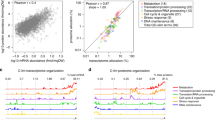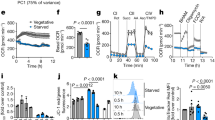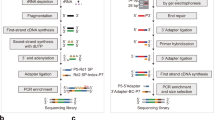Abstract
Cell cycle progression requires the coordination of cell growth, chromosome replication and division. Consequently, a functional cell cycle must be coupled with metabolism. However, direct measurements of metabolome dynamics remained scarce, in particular in bacteria. Here, we describe an untargeted metabolomics approach with synchronized Caulobacter crescentus cells to monitor the relative abundance changes of ~400 putative metabolites as a function of the cell cycle. While the majority of metabolite pools remain homeostatic, ~14% respond to cell cycle progression. In particular, sulfur metabolism is redirected during the G1–S transition, and glutathione levels periodically change over the cell cycle, with a peak in late S phase. A lack of glutathione perturbs cell size by uncoupling cell growth and division through dysregulation of KefB, a K+/H+ antiporter. Overall, we here describe the effects of the C. crescentus cell cycle progression on metabolism, and in turn relate glutathione and potassium homeostasis to timely cell division.
This is a preview of subscription content, access via your institution
Access options
Access Nature and 54 other Nature Portfolio journals
Get Nature+, our best-value online-access subscription
$29.99 / 30 days
cancel any time
Subscribe to this journal
Receive 12 digital issues and online access to articles
$119.00 per year
only $9.92 per issue
Buy this article
- Purchase on Springer Link
- Instant access to full article PDF
Prices may be subject to local taxes which are calculated during checkout





Similar content being viewed by others
Data availability
The metabolomics dataset generated during this study is available through a MetaboLights database entry (https://www.ebi.ac.uk/metabolights/) with the study identifier MTBLS1402. Other data that support the findings of this study are available from the corresponding authors upon request.
Code availability
The computer code for the described ‘pairfinder’ workflow is deposited at https://pypi.org/project/idms-pairfinder-2/.
References
Cai, L. & Tu, B. P. Driving the cell cycle through metabolism. Annu. Rev. Cell Dev. Biol. 28, 59–87 (2012).
Wang, J. D. & Levin, P. A. Metabolism, cell growth and the bacterial cell cycle. Nat. Rev. Microbiol. 7, 822–827 (2009).
Lee, I. H. & Finkel, T. Metabolic regulation of the cell cycle. Curr. Opin. Cell Biol. 25, 724–729 (2013).
Johnston, G. C., Pringle, J. R. & Hartwell, L. H. Coordination of growth with cell division in the yeast Saccharomyces cerevisiae. Exp. Cell Res. 105, 79–98 (1977).
Boye, E. & Nordstrom, K. Coupling the cell cycle to cell growth. EMBO Rep. 4, 757–760 (2003).
Wang, H. et al. The metabolic function of cyclin D3-CDK6 kinase in cancer cell survival. Nature 546, 426–430 (2017).
Ewald, J. C., Kuehne, A., Zamboni, N. & Skotheim, J. M. The yeast cyclin-dependent kinase routes carbon fluxes to fuel cell cycle progression. Mol. Cell 62, 532–545 (2016).
Saqcena, M. et al. Amino acids and mTOR mediate distinct metabolic checkpoints in mammalian G1 cell cycle. PLoS ONE 8, e74157 (2013).
Margolin, W. & Bernander, R. How do prokaryotic cells cycle? Curr. Biol. 14, R768–R770 (2004).
Jensen, R. B., Wang, S. C. & Shapiro, L. A moving DNA replication factory in Caulobacter crescentus. EMBO J. 20, 4952–4963 (2001).
Iba, H., Fukuda, A. & Okada, Y. Rate of major protein-synthesis during cell-cycle of Caulobacter crescentus. J. Bacteriol. 135, 647–655 (1978).
Beaufay, F. et al. A NAD-dependent glutamate dehydrogenase coordinates metabolism with cell division in Caulobacter crescentus. EMBO J. 34, 1786–1800 (2015).
Irnov, I. et al. Crosstalk between the tricarboxylic acid cycle and peptidoglycan synthesis in Caulobacter crescentus through the homeostatic control of ɑ-ketoglutarate. PLoS Genet. 13, 1–27 (2017).
Weart, R. B. et al. A metabolic sensor governing cell size in bacteria. Cell 130, 335–347 (2007).
Campos, M. et al. A constant size extension drives bacterial cell size homeostasis. Cell 159, 1433–1446 (2014).
Ronneau, S., Petit, K., De Bolle, X. & Hallez, R. Phosphotransferase-dependent accumulation of (p)ppGpp in response to glutamine deprivation in Caulobacter crescentus. Nat. Commun. 7, 11423 (2016).
Chiaverotti, T. A., Parker, G., Gallant, J. & Agabian, N. Conditions that trigger guanosine tetraphosphate accumulation in Caulobacter crescentus. J. Bacteriol. 145, 1463–1465 (1981).
Boutte, C. C. & Crosson, S. The complex logic of stringent response regulation in Caulobacter crescentus: starvation signalling in an oligotrophic environment. Mol. Microbiol. 80, 695–714 (2011).
Westfall, C. S. & Levin, P. A. Comprehensive analysis of central carbon metabolism illuminates connections between nutrient availability, growth rate, and cell morphology in Escherichia coli. PLoS Genet. 14, e1007205 (2018).
Radhakrishnan, S. K., Pritchard, S. & Viollier, P. H. Coupling prokaryotic cell fate and division control with a bifunctional and oscillating oxidoreductase homolog. Dev. Cell 18, 90–101 (2010).
Lori, C. et al. Cyclic di-GMP acts as a cell cycle oscillator to drive chromosome replication. Nature 523, 236–U278 (2015).
Fang, G. et al. Transcriptomic and phylogenetic analysis of a bacterial cell cycle reveals strong associations between gene co-expression and evolution. BMC Genomics 14, 450 (2013).
Laub, M. T. et al. Global analysis of the genetic network controlling a bacterial cell cycle. Science 290, 2144–2148 (2000).
Schrader, J. M. et al. Dynamic translation regulation in Caulobacter cell cycle control. Proc. Natl Acad. Sci. USA 113, E6859–E6867 (2016).
Zhou, B. et al. The global regulatory architecture of transcription during the Caulobacter cell cycle. PLoS Genet. 11, 1–17 (2015).
Wu, L. et al. Quantitative analysis of the microbial metabolome by isotope dilution mass spectrometry using uniformly 13C-labeled cell extracts as internal standards. Anal. Biochem. 336, 164–171 (2005).
Bueschl, C. et al. MetExtract II: a software suite for stable isotope-assisted untargeted metabolomics. Anal. Chem. 89, 9518–9526 (2017).
Wang, L. et al. Peak annotation and verification engine for untargeted LC-MS metabolomics. Anal. Chem. 91, 1838–1846 (2019).
Bennett, B. D. et al. Absolute metabolite concentrations and implied enzyme active site occupancy in Escherichia coli. Nat. Chem. Biol. 5, 593–599 (2009).
Kanehisa, M. et al. Data, information, knowledge and principle: back to metabolism in KEGG. Nucleic Acids Res. 42, D199–D205 (2014).
Kind, T. & Fiehn, O. Metabolomic database annotations via query of elemental compositions: mass accuracy is insufficient even at less than 1 ppm. BMC Bioinformatics 7, 234 (2006).
Lai, Z. J. et al. Identifying metabolites by integrating metabolome databases with mass spectrometry cheminformatics. Nat. Methods 15, 53–56 (2018).
Schrader, J. M. & Shapiro, L. Synchronization of Caulobacter crescentus for investigation of the bacterial cell cycle. J. Vis. Exp. 98, e52633 (2015).
Abel, S. et al. Bi-modal distribution of the second messenger c-di-GMP controls cell fate and asymmetry during the Caulobacter cell cycle. PLoS Genet. 9, e1003744 (2013).
Domian, I. J., Quon, K. C. & Shapiro, L. Cell type-specific phosphorylation and proteolysis of a transcriptional regulator controls the G1-to-S transition in a bacterial cell cycle. Cell 90, 415–424 (1997).
Christen, M. et al. Asymmetrical distribution of the second messenger c-di-GMP upon bacterial cell division. Science 328, 1295–1297 (2010).
Jensen, K. F., Dandanell, G., Hove-Jensen, B. & Willemoes, M. Nucleotides, nucleosides, and nucleobases. EcoSal Plus 3, 1–68 (2008).
Sekowska, A., Kung, H. F. & Danchin, A. Sulfur metabolism in Escherichia coli and related bacteria: facts and fiction. J. Mol. Microbiol. Biotechnol. 2, 145–177 (2000).
Gonzalez, D. et al. The functions of DNA methylation by CcrM in Caulobacter crescentus: a global approach. Nucleic Acids Res. 42, 3720–3735 (2014).
Masip, L., Veeravalli, K. & Georgioui, G. The many faces of glutathione in bacteria. Antioxid. Redox Signal. 8, 753–762 (2006).
Kosower, N. S. & Kosower, E. M. The glutathione status of cells. Int. Rev. Cytol. 54, 109–160 (1978).
Smirnova, G. V. & Oktyabrsky, O. N. Glutathione in bacteria. Biochem. (Mosc.) 70, 1199–1211 (2005).
Buescher, J. M. et al. A roadmap for interpreting (13)C metabolite labeling patterns from cells. Curr. Opin. Biotechnol. 34, 189–201 (2015).
Hartl, J., Kiefer, P., Meyer, F. & Vorholt, J. A. Longevity of major coenzymes allows minimal de novo synthesis in microorganisms. Nat. Microbiol. 2, 17073 (2017).
Schriek, U. & Schwenn, J. D. Properties of the purified APS-kinase from Escherichia coli and Saccharomyces cerevisiae. Arch. Microbiol. 145, 32–38 (1986).
Lillig, C. H. et al. Redox regulation of 3’-phosphoadenylylsulfate reductase from Escherichia coli by glutathione and glutaredoxins. J. Biol. Chem. 278, 22325–22330 (2003).
Apontoweil, P. & Berends, W. Glutathione biosynthesis in Escherichia coli K-12—properties of enzymes and regulation. Biochim. Biophys. Acta 399, 1–9 (1975).
Meisenzahl, A. C., Shapiro, L. & Jenal, U. Isolation and characterization of a xylose-dependent promoter from Caulobacter crescentus. J. Bacteriol. 179, 592–600 (1997).
Miller, S. et al. Identification of an ancillary protein, YabF, required for activity of the KefC glutathione-gated potassium efflux system in Escherichia coli. J. Bacteriol. 182, 6536–6540 (2000).
Ness, L. S. & Booth, I. R. Different foci for the regulation of the activity of the KefB and KefC glutathione-gated K+ efflux systems. J. Biol. Chem. 274, 9524–9530 (1999).
Booth, I. R., Epstein, W., Giffard, P. M. & Rowland, G. C. Roles of the trkB and trkC gene products of Escherichia coli in K+ transport. Biochimie 67, 83–89 (1985).
Roosild, T. P. et al. Mechanism of ligand-gated potassium efflux in bacterial pathogens. Proc. Natl Acad. Sci. USA 107, 19784–19789 (2010).
Meury, J. & Kepes, A. Glutathione and the gated potassium channels of Escherichia coli. EMBO J. 1, 339–343 (1982).
Murata, K. & Kimura, A. Overproduction of glutathione and its derivatives by genetically engineered microbial cells. Biotechnol. Adv. 8, 59–96 (1990).
Kaczmarczyk, A., Vorholt, J. A. & Francez-Charlot, A. Cumate-inducible gene expression system for sphingomonads and other Alphaproteobacteria. Appl. Environ. Microbiol. 79, 6795–6802 (2013).
Grunenfelder, B. et al. Proteomic analysis of the bacterial cell cycle. Proc. Natl Acad. Sci. USA 98, 4681–4686 (2001).
Ahn, E. et al. Temporal fluxomics reveals oscillations in TCA cycle flux throughout the mammalian cell cycle. Mol. Syst. Biol. 13, 953 (2017).
Tu, B. P. et al. Cyclic changes in metabolic state during the life of a yeast cell. Proc. Natl Acad. Sci. USA 104, 16886–16891 (2007).
Murray, D. B., Beckmann, M. & Kitano, H. Regulation of yeast oscillatory dynamics. Proc. Natl Acad. Sci. USA 104, 2241–2246 (2007).
Tu, B. P., Kudlicki, A., Rowicka, M. & McKnight, S. L. Logic of the yeast metabolic cycle: temporal compartmentalization of cellular processes. Science 310, 1152–1158 (2005).
Bohrer, A. S. & Takahashi, H. Compartmentalization and regulation of sulfate assimilation pathways in plants. Int. Rev. Cell Mol. Biol. 326, 1–31 (2016).
Alam, M. T. et al. The self-inhibitory nature of metabolic networks and its alleviation through compartmentalization. Nat. Commun. 8, 16018 (2017).
Monahan, L. G. et al. Coordinating bacterial cell division with nutrient availability: a role for glycolysis. mBio 5, e00935-14 (2014).
Hardie, D. G. AMP-activated protein kinase: an energy sensor that regulates all aspects of cell function. Genes Dev. 25, 1895–1908 (2011).
Chen, Z., Odstrcil, E. A., Tu, B. P. & McKnight, S. L. Restriction of DNA replication to the reductive phase of the metabolic cycle protects genome integrity. Science 316, 1916–1919 (2007).
Goemans, C. V. et al. An essential thioredoxin is involved in the control of the cell cycle in the bacterium Caulobacter crescentus. J. Biol. Chem. 293, 3839–3848 (2018).
Narayanan, S., Janakiraman, B., Kumar, L. & Radhakrishnan, S. K. A cell cycle-controlled redox switch regulates the topoisomerase IV activity. Gene Dev. 29, 1175–1187 (2015).
Masrati, G. et al. Broad phylogenetic analysis of cation/proton antiporters reveals transport determinants. Nat. Commun. 9, 4205 (2018).
Chen, Y., Bjornson, K., Redick, S. D. & Erickson, H. P. A rapid fluorescence assay for FtsZ assembly indicates cooperative assembly with a dimer nucleus. Biophys. J. 88, 505–514 (2005).
Quon, K. C. et al. Negative control of bacterial DNA replication by a cell cycle regulatory protein that binds at the chromosome origin. Proc. Natl Acad. Sci. USA 95, 120–125 (1998).
Hottes, A. K., Shapiro, L. & McAdams, H. H. DnaA coordinates replication initiation and cell cycle transcription in Caulobacter crescentus. Mol. Microbiol. 58, 1340–1353 (2005).
Lariviere, P. J. et al. FzlA, an essential regulator of FtsZ filament curvature, controls constriction rate during Caulobacter division. Mol. Microbiol. 107, 180–197 (2018).
Martin, M. E., Trimble, M. J. & Brun, Y. V. Cell cycle-dependent abundance, stability and localization of FtsA and FtsQ in Caulobacter crescentus. Mol. Microbiol. 54, 60–74 (2004).
Ohta, N. et al. Identification, characterization, and chromosomal organization of cell division cycle genes in Caulobacter crescentus. J. Bacteriol. 179, 2169–2180 (1997).
Banerjee, S. et al. Biphasic growth dynamics control cell division in Caulobacter crescentus. Nat. Microbiol. 2, 17116 (2017).
Si, F. et al. Mechanistic origin of cell-size control and homeostasis in bacteria. Curr. Biol. 29, 1760–1770 e1767 (2019).
Lambert, A. et al. Constriction rate modulation can drive cell size control and homeostasis in C. crescentus. iScience 4, 180–189 (2018).
Ducret, A., Quardokus, E. M. & Brun, Y. V. MicrobeJ, a tool for high throughput bacterial cell detection and quantitative analysis. Nat. Microbiol. 1, 16077 (2016).
Ely, B. Genetics of Caulobacter crescentus. Methods Enzymol. 204, 372–384 (1991).
Bolten, C. J. et al. Sampling for metabolome analysis of microorganisms. Anal. Chem. 79, 3843–3849 (2007).
Mulleder, M., Bluemlein, K. & Ralser, M. A high-throughput method for the quantitative determination of free amino acids in Saccharomyces cerevisiae by hydrophilic interaction chromatography-tandem mass spectrometry. Cold Spring Harb. Protoc. 2017, pdb prot089094 (2017).
Kiefer, P., Schmitt, U. & Vorholt, J. A. eMZed: an open source framework in Python for rapid and interactive development of LC/MS data analysis workflows. Bioinformatics 29, 963–964 (2013).
Kiefer, P. et al. DynaMet: a fully automated pipeline for dynamic LC-MS data. Anal. Chem. 87, 9679–9686 (2015).
Horn, D. M., Zubarev, R. A. & McLafferty, F. W. Automated reduction and interpretation of high resolution electrospray mass spectra of large molecules. J. Am. Soc. Mass Spectrom. 11, 320–332 (2000).
Feist, A. M. et al. A genome-scale metabolic reconstruction for Escherichia coli K-12 MG1655 that accounts for 1260 ORFs and thermodynamic information. Mol. Syst. Biol. 3, 121 (2007).
Thanbichler, M., Iniesta, A. A. & Shapiro, L. A comprehensive set of plasmids for vanillate- and xylose-inducible gene expression in Caulobacter crescentus. Nucleic Acids Res. 35, e137 (2007).
Kaczmarczyk, A. et al. Precise transcription timing by a second-messenger drives a bacterial G1/S cell cycle transition. Preprint at bioRxiv https://doi.org/10.1101/675330 (2019).
Kaczmarczyk, A., Vorholt, J. A. & Francez-Charlot, A. Markerless gene deletion system for sphingomonads. Appl. Environ. Microbiol. 78, 3774–3777 (2012).
Deatherage, D. E. & Barrick, J. E. Identification of mutations in laboratory-evolved microbes from next-generation sequencing data using breseq. Methods Mol. Biol. 1151, 165–188 (2014).
Acknowledgements
We thank P. Christen (ETH Zurich) for technical support with LC–MS, J. v. Gienanth and C. Marulli (ETH Zurich) for experimental assistance in the early stages of this project, and J. Bögli and S. Stefanova (FACS Core Facility, Biozentrum, University of Basel) for help with flow cytometry. This work was supported by the Swiss National Science Foundation (grant no. 31003A_173094) and ETH Zurich to J.A.V., and by the Swiss National Science Foundation (grant no. 166503 and no. 185372) and an ERC Advanced Research Grant (grant no. 322809) to U.J.
Author information
Authors and Affiliations
Contributions
J.H. and J.A.V. conceived the project. J.H. synchronized cells. J.H. and F.M. prepared the metabolomics samples. J.H. performed LC–MS measurements. J.H. and P.K. developed the algorithm for metabolite detection and quantification and performed data analysis. A.K. and U.J. planned and performed genetic manipulations, growth experiments and FACS measurements. J.H., A.K. and M.M. performed microscopy and image analysis. T.V. and B.H. performed elemental analysis. J.H. and J.A.V. wrote the manuscript with input from all authors.
Corresponding authors
Ethics declarations
Competing interests
The authors declare no competing interests.
Additional information
Peer review information Primary Handling Editor: Pooja Jha.
Publisher’s note Springer Nature remains neutral with regard to jurisdictional claims in published maps and institutional affiliations.
Supplementary information
Supplementary Information
Supplementary Figs. 1–24, Methods and References
Supplementary Data 1
Cell cycle-dependent abundance profiles of metabolite features detected by LC–MS (nLC-QEx).
Supplementary Data 2
Cell cycle-dependent abundance profiles of metabolite features detected by LC–MS (UPLC-LTQ).
Supplementary Data 3
Clustermap of all metabolite abundance profiles throughout one cell cycle.
Supplementary Data 4
MS/MS spectra used for metabolite annotation.
Supplementary Data 5
Whole-genome sequencing results.
Rights and permissions
About this article
Cite this article
Hartl, J., Kiefer, P., Kaczmarczyk, A. et al. Untargeted metabolomics links glutathione to bacterial cell cycle progression. Nat Metab 2, 153–166 (2020). https://doi.org/10.1038/s42255-019-0166-0
Received:
Accepted:
Published:
Issue Date:
DOI: https://doi.org/10.1038/s42255-019-0166-0
This article is cited by
-
Pyruvate kinase, a metabolic sensor powering glycolysis, drives the metabolic control of DNA replication
BMC Biology (2022)
-
Peptidoglycan recycling mediated by an ABC transporter in the plant pathogen Agrobacterium tumefaciens
Nature Communications (2022)
-
Ultra-high-performance liquid chromatography high-resolution mass spectrometry variants for metabolomics research
Nature Methods (2021)
-
Reciprocal growth control by competitive binding of nucleotide second messengers to a metabolic switch in Caulobacter crescentus
Nature Microbiology (2020)



